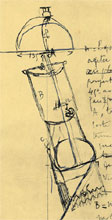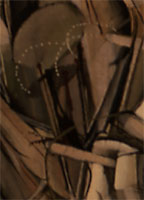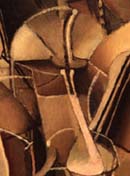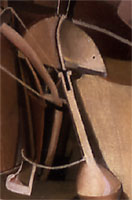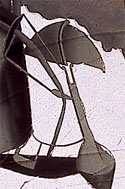|
|||||||||||||||||||||||||
|
"In mathematics, it goes from a very simple theorem to a very complicated one", as Marcel Duchamp concludes his important interview with Pierre Cabanne, "but it's all in the first theorem. So, metaphysics: tautology; religion: tautology: everything is tautology, except black coffee because the senses are in control! [...] but the rest is always tautology".(3) For Duchamp, however, not only metaphysics, religion and all the rest, but also grammatical gender, and especially the sexual identities in terms of which he elaborates it, are also tautological. Here, the "very simple theorem" is the conventional division of words, in Romance languages, into masculine and feminine--and the "very complicated theorem", by contrast, the unconventional sexual identities in terms of which Duchamp elaborates grammatical gender. Indeed, Duchamp's is the distinctly modern realization that necessarily precedes alternative (e.g. feminist and queer) sexual identities, and makes them possible in the first place: the identification of gender also as a surface no less constructed than that of language or of painting.
The strange affinity, in this respect, of Manet's Mlle. V... in the Costume of an Espada (1862) to R[r]ose Sélavy's first autograph work, Fresh Widow (1920) (Fig. 1)--in fact, a French window--is exemplary. "Woman", as a political signifier, Mlle. V reduces to the essential equivalence of painting and drag as similarly factitious; and "Spain", as an historical signifier, it self-consciously eschews in favor of a stylish "Espagnolisme". Like Mlle. V in drag, whether commenting on the making of Modernist art or the formation of modern sexual identity, Fresh Widow is also, first and foremost, a construct(ion). Analogous to language, it is made by another (the carpenter Duchamp hires) and acquired by oneself only as another (signed, albeit in block letters, by R[r]ose Sélavy). As such, it is so perfectly transparent to itself (a French window) that in order to obtain meaning it need at first achieve at least contingent opacity: whether as a French window or a fresh widow, either way, habillée en noir. In this sense, perhaps there can be no more thoroughly modern surface than the perfectly flat and opaque, black leather curtain with which Fresh Widow both occludes the "window on the world" of Renaissance perspective and, at once, asserts the analogous untransparency of modern sexual identity.(4) To Manet's equivalence of painting and drag, their relationship to language as similarly gendered and factitious is Duchamp's essential contribution. Indeed, the mind reels at all the wonderfully non-literal translations we might come up with for one of the venerably venereal quips Duchamp so loved to invent: "A charge de revanche; à verge de rechange" [Owe a favor; replace a penis].(5) "Even Steven's" comes quickly to mind, as does, with malaprop dexterity, "Procastrination". Yet any such translation begs the more seminal question, what exactly is a "replacement penis"?--and what kind of favor can one possibly repay with tender of this sort? Although the debt here is obviously masculine, elsewhere--by Duchamp's own admission, throughout his works--the downpayment is expressly feminine, as when he observes: "l'arrhe de la peinture est du genre féminin" [the downpayment / art of painting is feminine in gender] (DDS 37; WMD 24). In this economy in which literary and artistic transactions freely participate in sexual exchange, another of the artist's fundamental "laws" as he calls them--"'cuttage' in reserve" which, he enigmatically pronounces, is limited to "razor blades which cut well" (DDS 47; WMD 31)--reveals the common currency of both the debt and downpayment of Duchamp's art to be neither castration exactly, nor its anxiety really, but rather the essential reversibility of the male-female dyad which both underlies and structures his works more generally.
In a series of
doublets more than worthy of Duchamp at his most playful--"virgin
/ bride, vierge / verge, peindre / [pendre], passeur
/ pas soeur!, Cézanne / Suzanne"(8)--de
Duve analogously locates the phallus at the fulcrum of a variety of
sexual (ex)changes, or "passages", which structure not only
the artist's title painting, The Passage from Virgin to Bride (1912) (Fig. 4),
but also his earliest signature works more generally. What separates
Duchamp's Vierge [Virgin] (1912) (Fig.
5) from his Mariée [Bride] (1912) (Fig. 6) is exactly "'cuttage'
in reserve"; or, as de Duve explains, a difference of "I",
"the lacking signifier", which is "the phallus, the signifier
of lack".(9)
Thus, get rid of the "I" in "vierge" [virgin], as
he observes, and you have "verge" [penis]:(10)
the sign of her loss of virginity. Similarly, get rid of the "I"
in "peindre" [to paint], and you have "pendre" [to
hang].(11)
Although beginning as "a woman to be painted"--as both Duchamp's
Virgin and virgin canvas--the Bride nevertheless ends up as
"a woman to be hanged";(12)
or, as de Duve concludes, "[once] a woman painted, in the past
participle, the Bride will now be called 'le pendu femelle' (hanged female)".(13)
Yet, neither "woman
to be hanged", nor certainly "hanged female", truly embraces
the genital-as-zoological quality of "Le Pendu Femelle"--both
the most abstract and also the most ambivalent of Duchamp's figurations
of the "phallesse"--which I would instead translate
as "the female of the species which is male and hangs". For
as a "hanged" and, in this sense, a dead woman, Duchamp's
"Le Pendu Femelle" at once presents a dead end: a sign otherwise
without reference in his works.(14)
Yet, as establishing an essential homology between her sex and his own,(15)
as between these and painting in turn--à la Renoir's famous dictum,
that he paints "with his prick" (cf. DDS 239)--its
relevance to Duchamp's works could not be more manifest. Here, where
neither member is on top, but potentially both at the same time--and
Mar-Cel doubly identifies as both "Mar[iée]" and "Cél[ibataire]":
"Bride" and "Bachelor"--Rrose lifts her skirts to
reveal the most traumatic sign of gender difference of all: for Duchamp,
its essential indifference. Neither sexually nor linguistically,
neither "his" nor "hers" alone, "Le Pendu Femelle"
is just such a reversibly gendered, anatomical cipher--or, "phallesse".
Although Duchamp's explicit figurations of "Le Pendu Femelle"
are already several--and variously observable in the Passage,
Bride and, severed from this last, the Large Glass (Fig. 7(c)-(e))--these merely reiterate an anterior,
even atavistic formal prototype, according to which (with disconcerting,
Apollinaire-like simplicity, no doubt) insert rod or piston into circle
or semicircle, sphere or demisphere. Georges Bataille perfectly captures
the formal logic of "Le Pendu Femelle" when he similarly identifies
the "two primary motions"--"rotation and sexual movement"--to
the rotating wheels of the locomotive (like the semicircular head of
"Le Pendu Femelle"), driven by the in-and-out thrust of its
pistons (exactly how Duchamp mechanically renders Le Pendu Femelle
(1913) in Fig. 7(a)).(16)
>>Next
Notes
This article is a chapter of the dissertation I recently completed writing at the Institute of Fine Arts, New York University ("When Father Doesn't Know Best: Surrealism, Metaphor, Masculinity"), where it was originally presented in 1998 as part of a methodology seminar led by Robert Lubar. My great thanks, for their engaged and challenging criticism, are also owing to Jenny Liu, Linda Nochlin, Katherine Smith and Deborah Vischak.
Figs.
1-7
|
|||||||||||||||||||||||||






